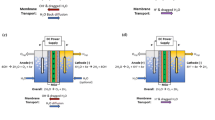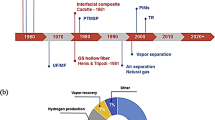Abstract
Hybrid membranes based on polyvinyl chloride (PVC) containing 1–5 wt% of titanium dioxide anatase (TiO2 anatase) particles were prepared via the casting solution method. These membranes were characterized by XRD, FTIR, TGA, SEM, EDX, and contact angle measurements. The pervaporation (PV) and separation characteristics of toluene/n-heptane mixtures containing 50 wt% through these membranes were investigated at 56 °C. The membranes flux increased with increasing TiO2 anatase content, and the selectivity decreased; however, a significant improvement in PV performance was observed for membranes loaded with TiO2 anatase compared to pure PVC. The PVC membrane loaded with 2 wt% TiO2 anatase showed the highest separation factor of 6.27 with a normalized flux of 0.55 kg/m2.h where in absence of TiO2 anatase the corresponding values were 9.7 and 0.05 kg/m2.h.














Similar content being viewed by others
References
Ong YK, Shi GM, Le NL, Tang YP, Zuo J, Nunes SP, Chung T-S (2016) Recent membrane development for pervaporation processes. Prog Polym Sci 57:1–31. https://doi.org/10.1016/j.progpolymsci.2016.02.003
Veerapur RS, Patil MB, Gudasi KB, Aminabhavi TM (2008) Poly(vinyl alcohol)–zeolite T mixed matrix composite membranes for pervaporation separation of water + 1,4-dioxane mixtures. Sep Purif Technol 58:377–385. https://doi.org/10.1016/j.seppur.2007.05.015
Adoor SG, Prathab B, Manjeshwar LS, Aminabhavi TM (2007) Mixed matrix membranes of sodium alginate and poly(vinyl alcohol) for pervaporation dehydration of isopropanol at different temperatures. Polymer 48:5417–5430. https://doi.org/10.1016/j.polymer.2007.06.064
Krishna Rao KSV, Subha MCS, Sairam M, Mallikarjuna NN, Aminabhavi TM (2007) Blend membranes of chitosan and poly(vinyl alcohol) in pervaporation dehydration of isopropanol and tetrahydrofuran. J Appl Polym Sci 103:1918–1926. https://doi.org/10.1002/app.25078
Upadhyaya L, Chiao Y-H, Wickramasinghe SR, Qian X (2020) Cu (I/II) metal-organic frameworks incorporated nanofiltration membranes for organic solvent separation. J Membranes 10(11):313. https://doi.org/10.3390/membranes10110313
Patil MB, Aminabhavi TM (2008) Pervaporation separation of toluene/alcohol mixtures using silicalite zeolite embedded chitosan mixed matrix membranes. Sep Purif Technol 62:128–136. https://doi.org/10.1016/j.seppur.2008.01.013
Bhat SD, Aminabhavi TM (2009) Pervaporation-aided dehydration and esterification of acetic acid with ethanol using 4A Zeolite-filled cross-linked sodium alginate-mixed matrix membranes. J Appl Polym Sci 113:157–168. https://doi.org/10.1002/app.29545
Garcia Villaluenga JP, Tabe-Mohammadi A (2000) A review on the separation of benzene/cyclohexane mixtures by pervaporation processes. J Membr Sci 169:159–174. https://doi.org/10.1016/S0376-7388(99)00337-3
Suhas DP, Raghu AV, Jeong HM, Aminabhavi TM (2013) Graphene-loaded sodium alginate nanocomposite membranes with enhanced isopropanol dehydration performance via pervaporation technique. RSC Adv 3:17120–17130. https://doi.org/10.1039/C3RA42062K
Suhas DP, Aminabhavi TM, Raghu AV (2014) para-Toluene sulfonic acid treated clay loaded sodium alginate membranes for enhanced pervaporative dehydration of isopropanol. Appl Clay Sci 101:419–429. https://doi.org/10.1016/j.clay.2014.08.017
Suhas DP, Aminabhavi TM, Raghu AV (2014) Mixed matrix membranes of H-ZSM5-loaded poly(vinyl alcohol) used in pervaporation Dehydration of alcohols: influence of silica/alumina ratio. Polym Eng Sci 54:1774–1782. https://doi.org/10.1002/pen.23717
Suhas DP, Aminabhavi TM, Jeong HM, Raghu AV (2015) Hydrogen peroxide treated graphene as an effective nanosheet filler for separation application. RSC Adv 5:100984–100995. https://doi.org/10.1039/C5RA19918B
Wang N, Ji S, Li J, Zhang R, Zhang G (2014) Poly (vinylalcohol)–graphene oxide nanohybrid “pore-filling” membrane for pervaporation of toluene/n-heptane mixtures. J Membr Sci 455:113–120. https://doi.org/10.1016/j.memsci.2013.12.023
Teli SB, Gokavi GS, Sairam M, Aminabhavi TM (2007) Mixed matrix membranes of poly(vinyl alcohol) loaded with phosphomolybdic heteropolyacid for the pervaporation separation of water–isopropanol mixtures. Coll Surf: Physicochem Eng Aspects 301:55–62. https://doi.org/10.1016/j.colsurfa.2006.12.030
Cheng X, Pan F, Wang M, Li W, Song Y, Liu G, Yang H, Gao B, Wu H, Jiang Z (2017) Hybrid membranes for pervaporation separations. J Membr Sci 541:329–346. https://doi.org/10.1016/j.memsci.2017.07.009
Jyothi MS, Reddy KR, Soontarapa K, Naveen S, Raghu AV, Kulkarni RV, Suhas DP, Shetti NP, Nadagouda MN, Aminabhavih TM (2019) Membranes for dehydration of alcohols via pervaporation. J Environ Manage 242:415–429. https://doi.org/10.1016/j.jenvman.2019.04.043
Baker RW (2004) Membrane technology and applications. In: Wiley J, Ltd S (eds) Membranes and modules, 2nd edn. Hoboken NJ, USA, pp 89–160
Buekenhoudt A, Kovalevsky A, Luyten Ir J, Snijkers F (2010) 1.11-Basic aspects in inorganic membrane preparation. Comprehensive Membr Sci Eng 1:217–252. https://doi.org/10.1016/B978-0-08-093250-7.00011-6
Davey CJ, Leak D, Patterson DA (2016) Hybrid and mixed matrix membranes for separations from fermentations. J Membr 6(1):17. https://doi.org/10.3390/membranes6010017
Roy S, Singha NR (2017) Polymeric nanocomposite membranes for next generation pervaporation process: strategies challenges and future prospects. J Membr 7(3):53. https://doi.org/10.3390/membranes7030053
Liu S, Liu G, Zhao X, Jin W (2013) Hydrophobic-ZIF-71 filled PEBA mixed matrix membranes for recovery of biobutanol via pervaporation. J Membr Sci 446:181–188. https://doi.org/10.1016/j.memsci.2013.06.025
Behboudi A, Jafarzadeh Y, Yegani R (2016) Preparation and characterization of TiO2 embedded PVC ultrafiltration membranes. Chem Eng Res Des 114:96–107. https://doi.org/10.1016/j.cherd.2016.07.027
Yang Y, Zhang H, Wang P, Zheng Q, Li J (2007) The influence of nano-sized TiO2 fillers on the morphologies and properties of PSF UF membrane. J Membr Sci 288:231–238. https://doi.org/10.1016/j.memsci.2006.11.019
Shi D, Li P, Cao B (2016) Preparation of PDMS/PVDF Composite pervaporation membrane modified with hydrophobic TiO2 nanoparticles for separating formaldehyde solution. J Polym Sci 2:1. https://doi.org/10.4172/2471-9935.100012
Yang D, Li J, Jiang Z, Lu L, Chen X (2009) Chitosan/TiO2 nanocomposite pervaporation membranes for ethanol dehydration. J Chem Eng Sci 64:3130–3137. https://doi.org/10.1016/j.ces.2009.03.042
Zhu T, Lin Y, Luo Y, Hu X, Lin W, Yu P, Huang C (2012) Preparation and characterization of TiO2-regenerated cellulose inorganic–polymer hybrid membranes for dehydration of caprolactam. J Carbohydr Polym 87:901–909. https://doi.org/10.1016/j.carbpol.2011.08.088
Hasan M, Banerjee AN, Lee M (2015) Enhanced thermo-mechanical performance and strain-induced band gap reduction of TiO2/PVC nanocomposite films. Bull Mater Sci 38:283–290. https://doi.org/10.1007/s12034-014-0831-6
Aouinti L, Roizard D (2015) Pervaporation of toluene/n-heptane mixtures with hybrid PVC membranes containing inorganic particles. J Earth Sci Eng 5:473–481. https://doi.org/10.17265/2159-581X/2015.08.002
Aouinti L, Roizard D, Hu G, Thomas F, Belbachir M (2009) Investigation of pervaporation hybrid polyvinylchloride membranes for the separation of toluene –n heptane mixtures-Case of clays as filler. Desalination 241:174–181. https://doi.org/10.1016/j.desal.2007.12.049
Zhang Y, Wang N, Ji S, Zhang R, Zhao C, Li J-R (2015) Metal–organic framework /poly (vinyl alcohol) nanohybrid membrane for the pervaporation of toluene/n-heptane mixtures. J Membr Sci 489:144–152. https://doi.org/10.1016/j.memsci.2015.04.012
Néel J (1997) Pervaporation, Technique et Document, Lavoisier, Paris.
Abdel-Baset T, Elzayat M, Mahrous S (2016) Characterization and optical and dielectric properties of polyvinyl chloride/silica nanocomposites films. Int J Polymer Sci. https://doi.org/10.1155/2016/1707018
Antić Ž, Krsmanović RM, Nikolić MG, Marinović-Cincović M, Mitrić M, Polizzi S, Dramićanin MD (2012) Multisite luminescence of rare earth doped TiO2 anatase nanoparticles. Mat Chem Phys 135:1064–1069. https://doi.org/10.1016/j.matchemphys.2012.06.016
Ba-Abbad MM, Kadhum AAH, Mohamad A, Takriff MS, Sopian K (2012) Synthesis and catalytic activity of TiO2 nanoparticles for photochemical oxidation of concentrated chlorophenols under direct solar radiation. Int J Electrochem Sci 7:4871–4888
Pandey A, Sangeeta K, Chetna A, Rakshit A, Sudhish K, Pinki BP (2015) Synthesis, characterization and application of naїve and nano-sized titanium dioxide as a photocatalyst for degradation of methylene blue. J Saudi Chem Soc 19:528–536. https://doi.org/10.1016/j.jscs.2015.05.013
Socrates G (1994) Infrared characteristic group frequencies: Tables and charts. Wiley, New York
Beltrán M, Marcila A (1997) Fourier Transform infrared spectroscopy applied to the study of PVC decomposition. Eur Polym J 33:1135–1142
Dimiitrenko ME, Penkova AV, Kuzminova AI, Mahbub M, Larionov MI, Alem H, Zolotarev AA, Ermakov S, Roizard D (2018) Investigation of new modification strategies for PVA membranes to improve their dehydration properties by pervaporation. Appl Surf Sci 450:527–537
Wijmans JG, Baker RW (1995) The solution-diffusion model a review. J Membr Sci 107:1–21. https://doi.org/10.1016/0376-7388(95)00102-I
Aouinti L, Roizard D, Belbachir M (2015) PVC-activated carbon based matrices: A promising combination for pervaporation membranes useful for aromatic-aliphatic. J Sep Pur Technol. 147:51–61. https://doi.org/10.1016/j.seppur.2015.04.007
Zimmerman CM, Singh A, Koros WJ (1997) Tailoring mixed matrix composite membranes for gas separations. J Membr Sci 137:145–154. https://doi.org/10.1016/S0376-7388(97)00194-4
Aouinti L, Boukraa FDS, Chirane S, Mohand Arab S (2019) Preparation of PVC-NiFeCO3-hybrid membranes for the pervaporation separation of toluene-heptane mixtures. Int J Petrochem Res 3:269–273. https://doi.org/10.18689/ijpr-1000146
Peng F, Jiang Z, Hu C, Wang Y, Lu L, Wu H (2006) Pervaporation of benzene/ cyclohexane through poly(vinylalcohol) membranes with and without β-cyclodextrin. Desalination 193:182–192. https://doi.org/10.1016/j.desal.2005.04.141
Frahn J, Malsch G, Matuschewski H, Schedler U, Schwarz H-H (2004) Separation of aromatic/aliphatic hydrocarbons by photo-modified poly (acrylonitrile) membranes. J Membr Sci 234:55–65. https://doi.org/10.1016/j.memsci.2003.12.017
Wu T, Wang N, Li J, Wang L, Zhang W, Zhang C, Wu T, Ji S (2015) Tubular thermal crosslinked PEBA /Ceramic membrane for aromatic/aliphatic pervaporation. J Membr Sci 486:1–9. https://doi.org/10.1016/j.memsci.2015.03.037
Acknowledgments
The authors would like to thank the research team of the LRGP laboratory at Nancy, University of Lorraine, especially Denis Roizrad, director of the laboratory, for providing the Fourier transform infrared spectroscopy (FTIR), thermogravimetric analysis (TGA), laser diffraction, energy-dispersive x-ray spectroscopy (EDX) and scanning electron microscopy (SEM) analyses.
Author information
Authors and Affiliations
Corresponding author
Additional information
Publisher's Note
Springer Nature remains neutral with regard to jurisdictional claims in published maps and institutional affiliations.
Rights and permissions
About this article
Cite this article
Tabbiche, A., Aouinti, L. Preparation and characterization of nanocomposite membranes based on PVC/TiO2 anatase for the separation of toluene/n-heptane mixtures via pervaporation. Polym. Bull. 80, 643–666 (2023). https://doi.org/10.1007/s00289-021-04062-5
Received:
Revised:
Accepted:
Published:
Issue Date:
DOI: https://doi.org/10.1007/s00289-021-04062-5




